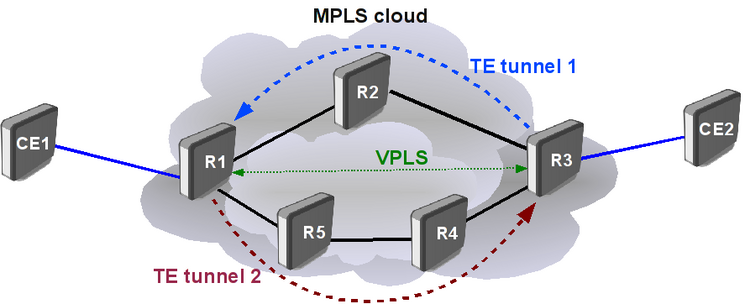Manual:TE Tunnels Example
Introduction
Application example
Consider following setup:
IP Connectivity and LDP
R1
ether1 connects to R2, ether2 connects to R5
/system identity set name=R1 /interface bridge add name=lo0 /ip address add address=192.168.55.1/30 interface=ether1 add address=192.168.55.18/30 interface=ether2 add address=10.255.1.1/32 interface=lo0 /routing ospf instance set default router-id=10.255.1.1 /routing ospf networks add network=192.168.55.0/24 area=backbone add network=10.255.1.0/24 area=backbone /mpls ldp set enabled=yes lsr-id=10.255.1.1 transport-address=10.255.1.1 /mpls ldp interface add interface=ether1 add interface=ether2
R2
ether1 connects to R1, ether2 connects to R3
/system identity set name=R2 /interface bridge add name=lo0 /ip address add address=192.168.55.2/30 interface=ether1 add address=192.168.55.5/30 interface=ether2 add address=10.255.1.2/32 interface=lo0 /routing ospf instance set default router-id=10.255.1.2 /routing ospf networks add network=192.168.55.0/24 area=backbone add network=10.255.1.0/24 area=backbone /mpls ldp set enabled=yes lsr-id=10.255.1.2 transport-address=10.255.1.2 /mpls ldp interface add interface=ether1 add interface=ether2
R3
ether1 connects to R2, ether2 connects to R4
/system identity set name=R3 /interface bridge add name=lo0 /ip address add address=192.168.55.6/30 interface=ether1 add address=192.168.55.9/30 interface=ether2 add address=10.255.1.3/32 interface=lo0 /routing ospf instance set default router-id=10.255.1.3 /routing ospf networks add network=192.168.55.0/24 area=backbone add network=10.255.1.0/24 area=backbone /mpls ldp set enabled=yes lsr-id=10.255.1.3 transport-address=10.255.1.3 /mpls ldp interface add interface=ether1 add interface=ether2
R4
ether1 connects to R3, ether2 connects to R5
/system identity set name=R4 /interface bridge add name=lo0 /ip address add address=192.168.55.10/30 interface=ether1 add address=192.168.55.13/30 interface=ether2 add address=10.255.1.4/32 interface=lo0 /routing ospf instance set default router-id=10.255.1.4 /routing ospf networks add network=192.168.55.0/24 area=backbone add network=10.255.1.0/24 area=backbone /mpls ldp set enabled=yes lsr-id=10.255.1.4 transport-address=10.255.1.4 /mpls ldp interface add interface=ether1 add interface=ether2
R5
ether1 connects to R4, ether2 connects to R1
/system identity set name=R5 /interface bridge add name=lo0 /ip address add address=192.168.55.14/30 interface=ether1 add address=192.168.55.17/30 interface=ether2 add address=10.255.1.5/32 interface=lo0 /routing ospf instance set default router-id=10.255.1.5 /routing ospf networks add network=192.168.55.0/24 area=backbone add network=10.255.1.0/24 area=backbone /mpls ldp set enabled=yes lsr-id=10.255.1.5 transport-address=10.255.1.5 /mpls ldp interface add interface=ether1 add interface=ether2
After OSPF and LDP setup ensure that ospf is working properly
[admin@R1] /routing ospf neighbor> print 0 instance=default router-id=10.255.1.5 address=192.168.55.17 interface=ether2 priority=1 dr-address=192.168.55.17 backup-dr-address=192.168.55.18 state="Full" state-changes=5 ls-retransmits=0 ls-requests=0 db-summaries=0 adjacency=32m17s 1 instance=default router-id=10.255.1.2 address=192.168.55.2 interface=ether1 priority=1 dr-address=192.168.55.2 backup-dr-address=192.168.55.1 state="Full" state-changes=5 ls-retransmits=0 ls-requests=0 db-summaries=0 adjacency=32m17s [admin@R1] /routing ospf neighbor>
[admin@R1] /ip route> print
Flags: X - disabled, A - active, D - dynamic,
C - connect, S - static, r - rip, b - bgp, o - ospf, m - mme,
B - blackhole, U - unreachable, P - prohibit
# DST-ADDRESS PREF-SRC GATEWAY DISTANCE
0 ADS 0.0.0.0/0 10.1.101.1 0
1 ADC 10.1.101.0/24 10.1.101.9 ether3 0
2 ADC 10.255.1.1/32 10.255.1.1 lo0 0
3 ADo 10.255.1.2/32 192.168.55.2 110
4 ADo 10.255.1.3/32 192.168.55.2 110
5 ADo 10.255.1.4/32 192.168.55.17 110
6 ADo 10.255.1.5/32 192.168.55.17 110
7 ADC 192.168.55.0/30 192.168.55.1 ether1 0
8 ADo 192.168.55.4/30 192.168.55.2 110
9 ADo 192.168.55.8/30 192.168.55.2 110
192.168.55.17
10 ADo 192.168.55.12/30 192.168.55.17 110
11 ADC 192.168.55.16/30 192.168.55.18 ether2 0
[admin@R1] /ip route>
Also make sure MPLS forwarding-table has label bindings
[admin@R1] /mpls forwarding-table> print Flags: L - ldp, V - vpls, T - traffic-eng # IN-LABEL OUT-LABELS DESTINATION I NEXTHOP 0 expl-null 1 L 16 10.255.1.5/32 e 192.168.55.17 2 L 17 19 192.168.55.8/30 e 192.168.55.2 3 L 18 19 10.255.1.4/32 e 192.168.55.17 4 L 19 21 10.255.1.3/32 e 192.168.55.2 5 L 20 192.168.55.12/30 e 192.168.55.17 6 L 21 192.168.55.4/30 e 192.168.55.2 7 L 22 10.255.1.2/32 e 192.168.55.2
VPLS tunnel
ether4 goes to CE routers
R1
/interface bridge add name=vpn /interface vpls add remote-peer=10.255.1.3 vpls-id=3:3 /interface bridge port add interface=ether4 bridge=vpn add interface=vpls1 bridge=vpn
R3
/interface bridge add name=vpn /interface vpls add remote-peer=10.255.1.1 vpls-id=3:3 /interface bridge port add interface=ether4 bridge=vpn add interface=vpls1 bridge=vpn
Make sure that VPLS tunnel is established and running
[admin@R1] /interface vpls> monitor 0 once
remote-label: 23
local-label: 23
remote-status:
transport: 10.255.1.3/32
transport-nexthop: 192.168.55.2
imposed-labels: 21,23
[admin@R1] /interface vpls>
TE Support
Traffic engineering needs RSVP protocol enabled on head end, tail end and forwarding routers. And additional setup to use CSPF.
In our example all routers have the same configuration:
# set up CSPF /routing ospf instance set default mpls-te-area=backbone mpls-te-router-id=lo0 # add interfaces on which to run RSVP /mpls traffic-eng interface add interface=ether1 bandwidth=10Mbps add interface=ether2 bandwidth=10Mbps
TE Tunnels
Secondary path
Reoptimization
